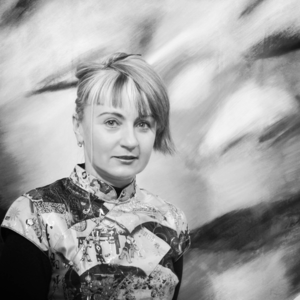Difference between revisions of "Oksana Chepelyk"
Angie Balzan (talk | contribs) (added picture) |
Angie Balzan (talk | contribs) (inserted more data) |
||
| Line 7: | Line 7: | ||
Chepelyk is an associate Professor of the National Academy of Arts and Architecture and | Chepelyk is an associate Professor of the National Academy of Arts and Architecture and | ||
Curator of the International Festival of Social Sculpture. | Curator of the International Festival of Social Sculpture. | ||
== '''Career''' == | |||
Her career began as an architect, studying Architecture at the Art Institute in Kiev (1978-1984). With the collapse of the USSR and the consequential lack of investment and opportunity, her innovative nature was redirected towards art, the theatre and fashion. | |||
Her transition into multimedia was sparked by the death of the theatre. Chepelyk was inspired to exhibit her theatrical, wearable creations but was not satisfied with just the documentation of these performances. She wanted to go a step futher, and as a result, she began filming. | |||
To explore working with the form, Chepelyk has taken part in several international residencies (France, Canada, Spain, UK, Germany) where she gradually outlined the key problems that she resolves with new, unexpected concepts. | |||
Oksana's artistic concerns have developed to encourage various dialogues between audiences. | |||
== '''1990s''' == | |||
In the 1990s, her work was predominantly focused on gender and its visual representation. | |||
This considered the commodification of women, sexuality within politics, mass consciousness, power and intercultural relations and the influence of history on the treatment of gender binaries. | |||
== '''2000s''' == | |||
After completing a program at the “Bauhaus Kolleg” (Dessau, Germany), Chepelyk began directing her art towards the social and aesthetic structures of urban life. She explores the synthesis of architectural spaces, contemporary aesthetics and new media. | |||
One of her methods is to connect theories of urban development with both contemporary and historical economic, ecological and demographic problems. | |||
The goal is to come closer to the understanding of spatial and temporal relations, interactions between media flow and the contemporary human being. | |||
Revision as of 04:24, 28 January 2020
Oksana Chepelyk is an established multimedia artist with a long repertoire of international exhibitions and residencies.
She is a researcher of the Modern Art Research Institute of the National Academy of Arts of Ukraine. Chepelyk is an associate Professor of the National Academy of Arts and Architecture and Curator of the International Festival of Social Sculpture.
Career
Her career began as an architect, studying Architecture at the Art Institute in Kiev (1978-1984). With the collapse of the USSR and the consequential lack of investment and opportunity, her innovative nature was redirected towards art, the theatre and fashion.
Her transition into multimedia was sparked by the death of the theatre. Chepelyk was inspired to exhibit her theatrical, wearable creations but was not satisfied with just the documentation of these performances. She wanted to go a step futher, and as a result, she began filming.
To explore working with the form, Chepelyk has taken part in several international residencies (France, Canada, Spain, UK, Germany) where she gradually outlined the key problems that she resolves with new, unexpected concepts.
Oksana's artistic concerns have developed to encourage various dialogues between audiences.
1990s
In the 1990s, her work was predominantly focused on gender and its visual representation. This considered the commodification of women, sexuality within politics, mass consciousness, power and intercultural relations and the influence of history on the treatment of gender binaries.
2000s
After completing a program at the “Bauhaus Kolleg” (Dessau, Germany), Chepelyk began directing her art towards the social and aesthetic structures of urban life. She explores the synthesis of architectural spaces, contemporary aesthetics and new media. One of her methods is to connect theories of urban development with both contemporary and historical economic, ecological and demographic problems.
The goal is to come closer to the understanding of spatial and temporal relations, interactions between media flow and the contemporary human being.
